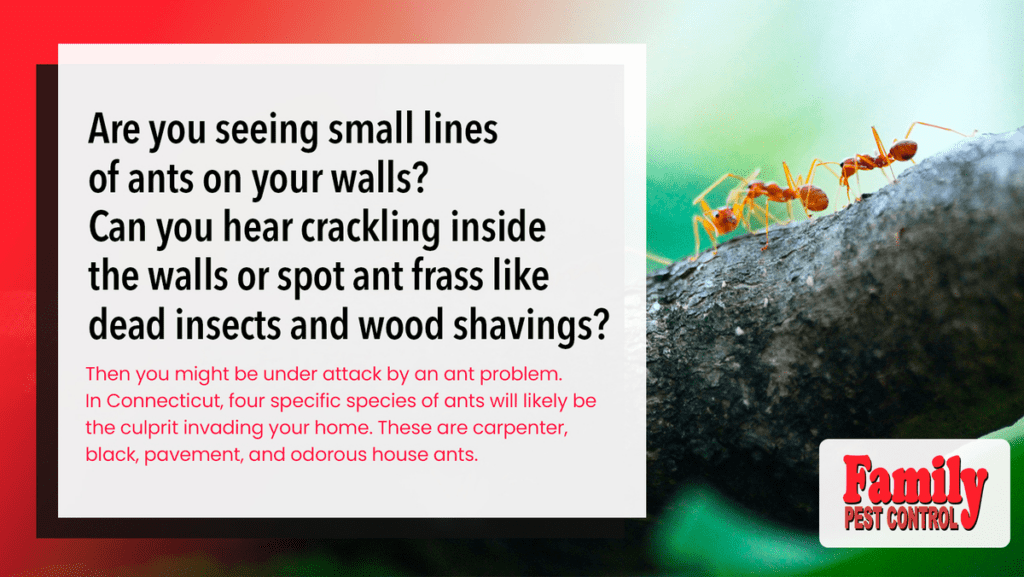All over the United States, there are at least more than 700 different ant species. Only 25 of this number are commonly found in homes. Ants are very social and like to live together in colonies underground. They have hierarchies from the top for queens and down to the bottom for their workers.
Ants are a type of pest that would eat anything, especially food leaning towards the sweeter kind. The identification of ants is simple. This is because they have three basic body regions: the abdomen, thorax, and head. But even if they have the same bodies, there are still distinctions between these species.
Are you seeing small lines of ants on your walls? Can you hear crackling inside the walls or spot ant frass like dead insects and wood shavings? Then you might be under attack by an ant problem. In Connecticut, four specific species of ants will likely be the culprit invading your home. These are carpenter, black, pavement, and odorous house ants.
Each of these ants can be active throughout the year. This is especially if the right conditions are there for their survival. Only carpenter ants are those who can cause degradation in your home. But regardless, any ant infestation is serious and should always be dealt with by professionals. Here is your guide as a homeowner for identifying what species of ants are invading your home and what to do next.

How Do You Identify an Ant Species?
You can identify an ant species by knowing its three distinct body regions: the head, abdomen and thorax, and antennae.
Over 25 different species of ants could invade your home worldwide, but there are four main suspects in Connecticut. These share similar traits and characteristics. There are six legs and antennae, but their differences may be in their sizes and colors.
Ants are very social insects and can live in colonies. Although small outside, inside can hold hundreds to thousands of ants. So if you think eliminating a small group might help, it might not. Inside your home, they might frequent some visits to the kitchen as a source of food. Some may visit the bathroom for its moisture.
Even outside, you can’t go anywhere and not spot an ant or two. These species crawl every surface of the planet one way or another. But they do belong outside, it can be alarming when swarms of them are in your home. If you think you’re suffering from an ant infestation, inspect the areas of your house with the most food and moisture.
Almost everyone knows what an ant looks like when spotting one. They are distinct because of their appearance, whether big or small or what color they are. But knowing the specific species of ant that is invading your home can be tricky if you see ants all the same. That is where this guide will help you, a homeowner. Discover which of the 4 most common Connecticut ants is frequenting your property.

What Are the Ants that Are in Your House?
Ants are small nuisances that may irritate your day-to-day tasks and activities. They are bothersome, but most people would likely see them as less of a threat. Despite that, you should still be cautious. Especially if ants have been prominent in your home for more than just a few days.
While there are several ant species, the ants that are in your house are pavement, little black, odorous house, and carpenter ants. To determine whether the ant is one that can cause serious damage to your home or not, there are a few things to look out for about these four.
1. Pavement Ants
Pavement ants are very reflective of their namesake. They nest underneath sidewalks or driveways. But when making their way inside homes, they often invade the spaces of your decks and patios. Pavement ants are small, measuring a little over a quarter of an inch. They vary between two color identifications: brown and black.
These ants are not considered a risk or dangerous, they pose as more of a nuisance rather than a danger. They do like to habilitate near home foundations. They travel towards food sources, mostly inside kitchens. This is through the crevices of the foundations. They gravitate strongly towards sweets, munching on some crumbs and trash.
2. Little Black Ants
They somewhat appear like pavement ants physically. They have the same brown-black appearance but appear much smaller than pavement ants. Some have wings, especially those that are reproductive. This is regardless of whether they are male or female.
This type of ant is one of the most common structural pests anyone can find, not just in Connecticut. They are adaptable and don’t mingle well with indoor colonies. They prefer to nest outdoors. Inside homes, you will most likely find infestations in close-knit locations. Colonies often rest inside voids of walls, cabinets, and inside foundations.
These infestations do not start on the inside, as they originate from the outdoors. If you have stumps, piles of lumber, or any trees near, you will often be at risk for an invasion of little black ants. While they are very annoying, the damage they can do is minimal.
3. Odorous House Ants
Like any other ant, these ants are very attracted to sweets, especially honeydew. They stay in big groups and colonies. But these ants have tendencies to move once every three months. This relocation is usually their response to rain.
When indoors, these odorous ants like to nest close to moist rooms and areas. You will find them near hot water pipes and heaters. As well as beneath leaky fixtures, sometimes inside any wood damaged by termites. Outdoors, these ants like living in exposed soil and sometimes underneath firewood.
These ants don’t pose many threats, but like any ant species, they can be annoying. They are also capable of contaminating your food.
4. Carpenter Ants
These ants lean towards the bigger side, ranging between a fourth of an inch or half an inch in length. Carpenter ants get their name because of how they build nests, where they excavate wood and build tunnels inside of it. Contrary to popular belief, though, carpenter ants are not wood-eaters. They tunnel and chew through the wood so they can nest inside of it.
The sign of carpenter ants infestation is small cracks on wood surfaces. In these openings, the ants expel debris. These consist of sawdust shavings or insect body parts. When this accumulates, you can assume you have an infestation of this species ongoing.

How to Get Rid of Ants
It can be challenging to get rid of ants, especially if the infestation has built up over time. Even if you only see a few gatherings in your home, this is only a small part of the colony.
Ants are harmless. The most dangerous thing you can encounter in your home will back a nasty bite that leaves you itching. Although, remember that their primary goal is to seek out food, so the first place you can look at is your kitchen.
https://platform.twitter.com/embed/Tweet.html?dnt=true&embedId=twitter-widget-0&features=eyJ0ZndfdGltZWxpbmVfbGlzdCI6eyJidWNrZXQiOltdLCJ2ZXJzaW9uIjpudWxsfSwidGZ3X2ZvbGxvd2VyX2NvdW50X3N1bnNldCI6eyJidWNrZXQiOnRydWUsInZlcnNpb24iOm51bGx9LCJ0ZndfdHdlZXRfZWRpdF9iYWNrZW5kIjp7ImJ1Y2tldCI6Im9uIiwidmVyc2lvbiI6bnVsbH0sInRmd19yZWZzcmNfc2Vzc2lvbiI6eyJidWNrZXQiOiJvbiIsInZlcnNpb24iOm51bGx9LCJ0ZndfZm9zbnJfc29mdF9pbnRlcnZlbnRpb25zX2VuYWJsZWQiOnsiYnVja2V0Ijoib24iLCJ2ZXJzaW9uIjpudWxsfSwidGZ3X21peGVkX21lZGlhXzE1ODk3Ijp7ImJ1Y2tldCI6InRyZWF0bWVudCIsInZlcnNpb24iOm51bGx9LCJ0ZndfZXhwZXJpbWVudHNfY29va2llX2V4cGlyYXRpb24iOnsiYnVja2V0IjoxMjA5NjAwLCJ2ZXJzaW9uIjpudWxsfSwidGZ3X3Nob3dfYmlyZHdhdGNoX3Bpdm90c19lbmFibGVkIjp7ImJ1Y2tldCI6Im9uIiwidmVyc2lvbiI6bnVsbH0sInRmd19kdXBsaWNhdGVfc2NyaWJlc190b19zZXR0aW5ncyI6eyJidWNrZXQiOiJvbiIsInZlcnNpb24iOm51bGx9LCJ0ZndfdXNlX3Byb2ZpbGVfaW1hZ2Vfc2hhcGVfZW5hYmxlZCI6eyJidWNrZXQiOiJvbiIsInZlcnNpb24iOm51bGx9LCJ0ZndfdmlkZW9faGxzX2R5bmFtaWNfbWFuaWZlc3RzXzE1MDgyIjp7ImJ1Y2tldCI6InRydWVfYml0cmF0ZSIsInZlcnNpb24iOm51bGx9LCJ0ZndfbGVnYWN5X3RpbWVsaW5lX3N1bnNldCI6eyJidWNrZXQiOnRydWUsInZlcnNpb24iOm51bGx9LCJ0ZndfdHdlZXRfZWRpdF9mcm9udGVuZCI6eyJidWNrZXQiOiJvbiIsInZlcnNpb24iOm51bGx9fQ%3D%3D&frame=false&hideCard=false&hideThread=false&id=336031410815135744&lang=en&origin=https%3A%2F%2Ffamilypestct.com%2Fhomeowners-guide-to-identifying-ant-species%2F&sessionId=e5c48540fb289a39c7cb81c12f2795dd6435dd69&theme=light&widgetsVersion=2615f7e52b7e0%3A1702314776716&width=550px
Home remedies to get rid of ants included chalk, coffee and cinnamon, unsuccessful so far pic.twitter.com/fZeS1XuDHg— Ena Quinn (@Enaregina) May 19, 2013
Here are some objects that can help you get rid of ants around your home without the use of any strong chemicals:
- Chalk is a common home remedy for getting rid of ants. These contain calcium carbonate and help keep ants away. Spraying or spreading powdered chalk in some common ant areas can help keep them away.
- Lemons have never liked the smell of lemons, as they are bitter and sour, the complete opposite of what attracts ants which is sweets. You can use lemon juice with the water you use to clean the house, which helps keep them away.
- Like chalk, spreading salt near the areas where ants frequent and enter the house helps keep them away. Table salt has been proven as one of the cheapest and most accessible methods that can help you keep ants away. You can boil water with a lot of salt and spray areas where you think ants come from.
- Vinegar is one of the worst things an ant can encounter. Like lemons, they offer the same effect. What you can do with vinegar is mix it with water and add a few drops of any essential oil. Incorporate them with each other well. Sprinkle this solution on ants’ entry points. Though this isn’t an ant-killer, it helps significantly with refraining their entry.

How Do I Get Rid of Ants in My House Foundation?
Despite how little ants are, remember they come in hundreds if not thousands. They are persistent pests that even the highest quality of bug spray can never get rid of. When ants live in the foundation of your home, they’ll risk your family’s health and safety.
Whether it’s a carpenter ant, pavement ant, or any ant, they can and will contaminate the food and water you eat and drink. Carpenter ants even ruin and damage your home’s foundation. Always try to deal with them using the correct commercial tools. But if the desired results aren’t achieved, it may be time to call in some help from Family Pest Control.

What steps can you take, especially in ridding your home foundation of ants?
- Make sure to look around your house and its surroundings for debris or rotting wood. Sweep these areas clean and make sure none are left. Ants are more likely to rest under rocks and inside decomposed wood. This helps them spread much easier towards your home foundation. They can also nest inside the foundation if given enough time.
- Repair any cracks, broken parts, or holes that you can find in the foundation with your tools. Most likely, these will entail minor handiwork. Anyone can do it, even with tools you might have on hand or some you can easily buy at hardware stores.
Ants cannot teleport or magically move through walls and floors. Most likely, they are using small entryways that you can spot if you look close enough. Using epoxy-based caulk in filling hairline cracks or cement for patching holes may help. This will prevent the ants from entering the house and its foundation.
- Ants, no matter what kind they are, will gravitate towards food and anything sweet. These sweets can be used as bait to use in trapping the ants. Setting ant bait traps around your home is a good method. Putting them near your foundation acts as the first line of defense that you can do on your own. These may be easier to do especially if you place and set them up near the nests and anthills.
- Spray throughout the perimeter of your house foundation with some pesticide. Apply chemical controls around at least 2 feet away from the house and inside the foundation. It is important to focus on a home’s foundation. Consider its surroundings as well. This helps in reassuring yourself and ensuring anything you can do to remove the ants will work.
Getting rid of ants by yourself is not a difficult task. No need to worry, though, as this can be done with just a few handy tools and dedication.
Ants are still spreading after doing the steps above?? If nothing is working, it’s time to call in the professionals. Although there are only a few home-invading ants in Connecticut, they pose more significant problems. This is where Family Pest Control can come in to save you from the trouble.
Contacting professionals will save you time and money, especially if the problem persists. Family Pest Control can help you determine the classification of ants eating away at your food. We present the best tools and skills for extermination. Additionally, we can give you tips for any future occurrences, too!

